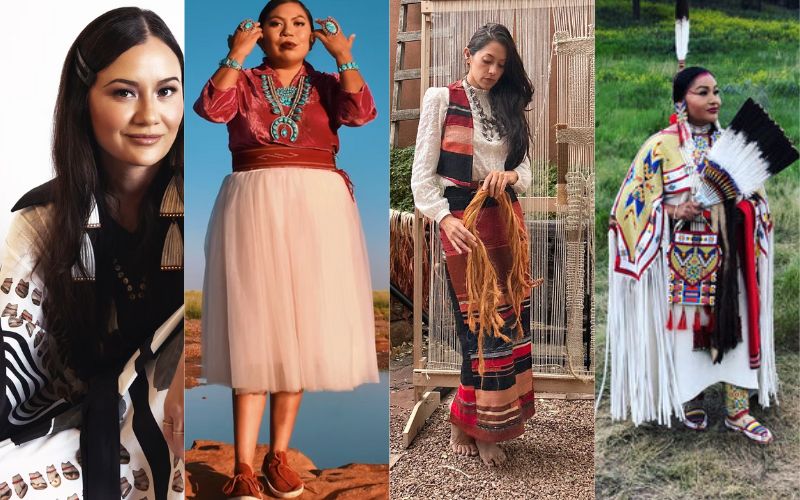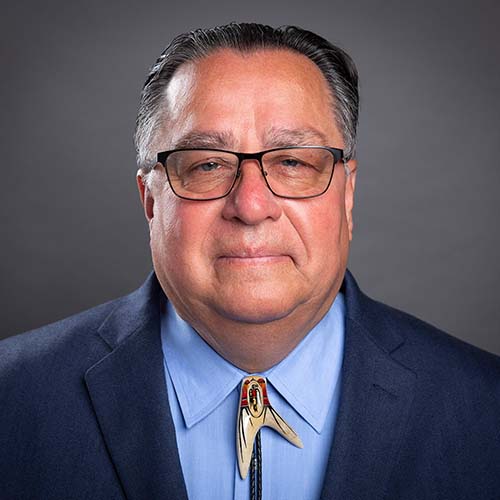
- Details
- By Elyse Wild
This Native American Heritage Month, Native News Online is celebrating by sharing our favorite Native American actors, movies, TV shows, books, chefs, musicians, artists, and fashion designers.
Since time immemorial, Indigenous people have executed textile, beadwork and craftsmanship into powerful cultural expressions. Today, Native designers are elevating their ancestral knowledge and cultural roots to new heights with luxury fashion designs that stun on the runway and shine on the red carpet.
From the deserts of the Navajo Nation to the studios of New York Fashion Week, Indigenous designers are rising in an industry that has long overlooked or appropriated their cultures. These artists are preserving traditional techniques to create bold, contemporary work that harkens to their ancestors, speaks to the present moment, and forges a future of design. Here is part one of Native American fashion designers you should know.
Naomi Glasses (Diné)
Seventh-generation Diné weaver Naiomi Glasses first garnered attention in 2021 for her TikTok videos of her skateboarding in the deserts of the Navajo Nation, dressed in traditional clothing.
While she has been selling her wares since 2015 and burst onto the international fashion scene in 2022 when she became the first artist-in-residence for the Ralph Lauren Corporation, co-designing a collection that incorporated traditional Diné motifs. Her work has been featured in iconic fashion media Vogue, Teen Vogue, Vogue Runway, Harper's Bazaar, and more.
Jamie Okuma (Luiseño, Shoshone-Bannock)
Hailing from the La Jolla Band Reservation in Southern California, Luiseño, Shoshone-Bannock designer Jamie Okuma grew up surrounded by the work of her ancestors; her mother is a renowned beadworker and painter, and much of Okuma's childhood was spent at the Southwest Museum of the American Indian in Los Angeles.
Today, her striking fashion reflects a lifetime of dedication to her craft. Signature elements to her designs include Indigenous patterns and dentalium shells, elk teeth, flowers and butterflies.
In 2023, Okuma became the first Native American inducted into The Council of Fashion Designers of America. This year, she made her New York Fashion Week debut.
She is a three-time winner of the Santa Fe Indian Market Best in Show, and her work Okuma's work is part of the permanent collection of the Metropolitan Museum of Art in New York City, the Minneapolis Institute of Art, the Nelson-Atkins Museum of Art, the Denver Art Museum and the Smithsonian's National Museum of the American Indian.
Lauren Good Day (Arikara, Hidatsa, Blackfeet and Plains Cree)
Based in her traditional homelands in North Dakota, Lauren Good Day is the designer behind a viral Indigenous Barbie t-shirt.
Good Day launched her fashion career in 2019, with a prolific output that includes an expansive collection of women's wear, men's wear and children's wear. Her garments often bear imagery from Great Plains tribal culture, such as bison and parade rider horses, in bold color palettes and are garnished with shells, sequins and beads. In 2023, Good Day told Elle Magazine that her designs aim to bring cultural traditions into the modern world.
"We hold onto our values. We live our culture daily, yet we still exist in this contemporary world as well. Our culture can still come with us wherever we go," she said.
Rhiannon Griego (Tohono O'odham)
Rhiannon Griego's work draws inspiration from the traditional Tohono O'odham basket weavers and aims to revive the once-lost art of garment weaving.
In a 2024 interview, Griego told the Huffington Post, "My process of reconnecting [to my Native heritage] is also about rekindling something that has been lost. It really feels like an interweaving of all of who I am."
Her works include tops, tunics, dresses, scarves and wall hangings, all hand-woven with silk, wool, hemp, and other materials Indigenous to her homelands, like agave, yucca and horsehair. A single piece can take up to 70 hours to make.
She has been featured in Vogue Knitting, HBO's Made for Love, and more.
More Stories Like This
Zuni Youth Enrichment Project Takes Top Emerging Artist Apprentices to Phoenix for Artistic Exploration and Cultural ImmersionFrom Dishwasher to Award-Winning Chef: Laguna Pueblo's Josh Aragon Serves Up Albuquerque's Best Green Chile Stew
Rob Reiner's Final Work as Producer Appears to Address MMIP Crisis
Vision Maker Media Honors MacDonald Siblings With 2025 Frank Blythe Award
First Tribally Owned Gallery in Tulsa Debuts ‘Mvskokvlke: Road of Strength’
Help us defend tribal sovereignty.
At Native News Online, our mission is rooted in telling the stories that strengthen sovereignty and uplift Indigenous voices — not just at year’s end, but every single day.
Because of your generosity last year, we were able to keep our reporters on the ground in tribal communities, at national gatherings and in the halls of Congress — covering the issues that matter most to Indian Country: sovereignty, culture, education, health and economic opportunity.
That support sustained us through a tough year in 2025. Now, as we look to the year ahead, we need your help right now to ensure warrior journalism remains strong — reporting that defends tribal sovereignty, amplifies Native truth, and holds power accountable.
 The stakes couldn't be higher. Your support keeps Native voices heard, Native stories told and Native sovereignty defended.
The stakes couldn't be higher. Your support keeps Native voices heard, Native stories told and Native sovereignty defended.
Stand with Warrior Journalism today.
Levi Rickert (Potawatomi), Editor & Publisher

